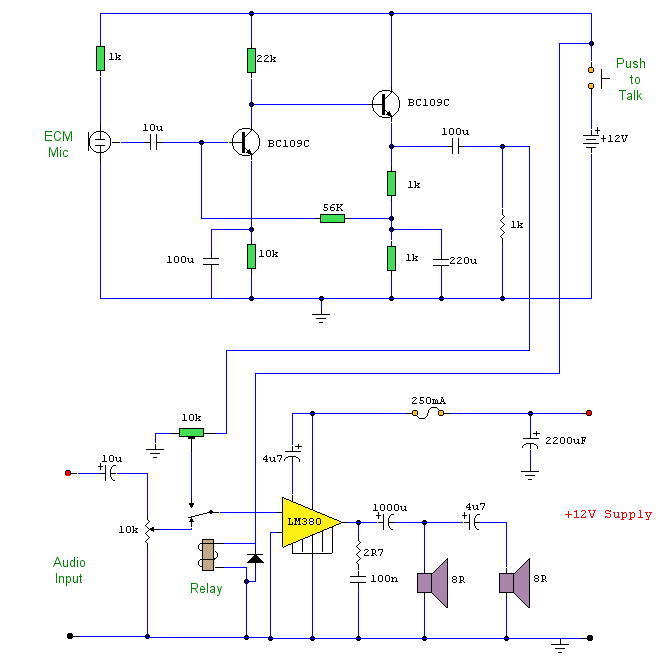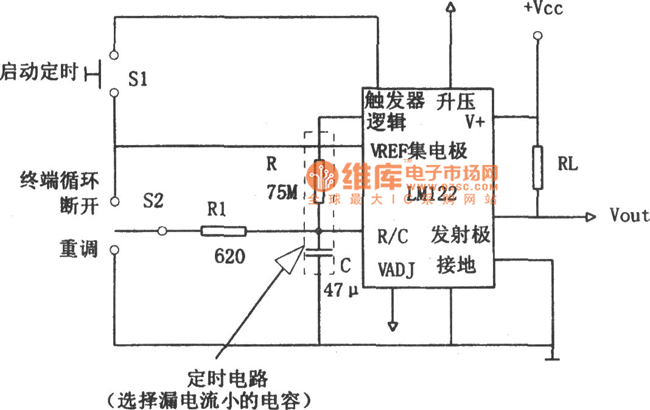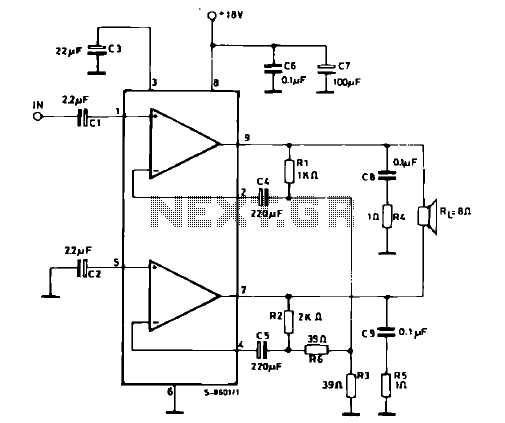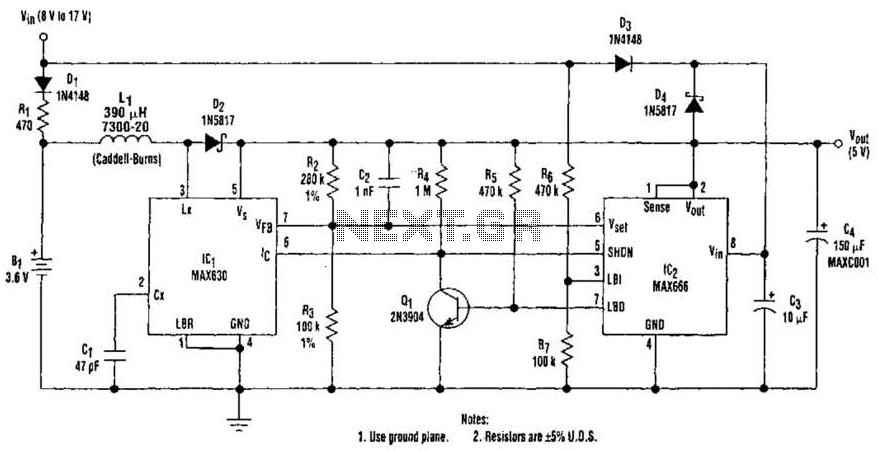
phase shift oscillator circuit

This design circuit features a simple, cost-effective amplitude-stabilized phase-shift sine wave oscillator that requires one integrated circuit (IC) package, three transistors, and operates from a single power supply. The circuit incorporates an RC network configured for phase shift, oscillating at approximately 12 kHz. The remaining components ensure amplitude stabilization. The schematic illustrates the circuit operation. The high-impedance output at the collector of Q2 is connected to the input of the LM386 through a 10 µF-1M series network. The circuit utilizes the LM386 operational amplifier, which has a fixed gain of 20. The 1M resistor, in conjunction with the internal 50 kΩ unit in the LM386, divides the output from Q2 by 20. The positive peaks at the amplifier output are rectified and stored in a 5 µF capacitor. This voltage is then supplied to the base of Q3. The collector current of Q3 varies based on the difference between its base and emitter voltages. As the emitter voltage is fixed by the LM313 1.2V reference, Q3 functions as a comparator, and its collector current modulates the base voltage of Q1. Q1, configured as an emitter follower, delivers servo-controlled drive to the Q2 oscillator.
The circuit operates by generating a stable sine wave output through a combination of phase-shifted feedback and amplitude stabilization. The phase shift is achieved using a network of resistors and capacitors that create the necessary delay for oscillation. The frequency of oscillation, approximately 12 kHz, is determined by the values of the resistors and capacitors in the RC network, allowing for adjustments based on component selection.
The LM386 operational amplifier is integral to the circuit's function, providing amplification with a fixed gain, which simplifies design considerations. The 10 µF capacitor in series with the 1M resistor serves to couple the output from Q2 to the LM386 input while blocking any DC offset, ensuring only the AC component of the signal is amplified.
The rectification process at the output of the LM386 converts the AC signal into a DC voltage, which is stored in the 5 µF capacitor. This stored voltage is crucial for controlling the base of Q3, allowing it to modulate the current that flows through Q1. The emitter follower configuration of Q1 ensures that the oscillator is driven with a stable voltage, thereby enhancing the overall stability of the sine wave output.
In summary, this circuit exemplifies an efficient design for generating a stable sine wave output using minimal components, making it suitable for various applications where a reliable signal source is required. The careful selection of components and their arrangement within the circuit ensures both amplitude stability and frequency accuracy.This is a design circuit of a simple inexpensive amplitude stabilized phase shift sine wave oscillator which requires one IC package, three transistors and runs off a single supply. This circuit is combination with the RC network comprises a phase shift configuration and oscillates at about 12 kHz.
The remaining circuitry provides amplitude stabil ity. Here`s the schematic figure of the circuit. The high impedance output at Q2s collector is fed to the input of the LM386 via the 10 F-1M series network. This circuit is using op amp LM386 causes it has fixed gain of 20. The 1M resistor in combination with the internal 50 k © unit in the LM386 divides Q2s output by 20. The positive peaks at the amplifier output are rectified and stored in the 5 F capacitor. This potential is fed to the base of Q3. Q3s collector current will vary with the difference between its base and emitter voltages. Since the emitter voltage is fixed by the LM313 1. 2V reference, Q3 performs a comparison function and its collector current modulates Q1s base voltage.
Q1, an emitter follower, provides servo controlled drive to the Q2 oscillator. 🔗 External reference
The circuit operates by generating a stable sine wave output through a combination of phase-shifted feedback and amplitude stabilization. The phase shift is achieved using a network of resistors and capacitors that create the necessary delay for oscillation. The frequency of oscillation, approximately 12 kHz, is determined by the values of the resistors and capacitors in the RC network, allowing for adjustments based on component selection.
The LM386 operational amplifier is integral to the circuit's function, providing amplification with a fixed gain, which simplifies design considerations. The 10 µF capacitor in series with the 1M resistor serves to couple the output from Q2 to the LM386 input while blocking any DC offset, ensuring only the AC component of the signal is amplified.
The rectification process at the output of the LM386 converts the AC signal into a DC voltage, which is stored in the 5 µF capacitor. This stored voltage is crucial for controlling the base of Q3, allowing it to modulate the current that flows through Q1. The emitter follower configuration of Q1 ensures that the oscillator is driven with a stable voltage, thereby enhancing the overall stability of the sine wave output.
In summary, this circuit exemplifies an efficient design for generating a stable sine wave output using minimal components, making it suitable for various applications where a reliable signal source is required. The careful selection of components and their arrangement within the circuit ensures both amplitude stability and frequency accuracy.This is a design circuit of a simple inexpensive amplitude stabilized phase shift sine wave oscillator which requires one IC package, three transistors and runs off a single supply. This circuit is combination with the RC network comprises a phase shift configuration and oscillates at about 12 kHz.
The remaining circuitry provides amplitude stabil ity. Here`s the schematic figure of the circuit. The high impedance output at Q2s collector is fed to the input of the LM386 via the 10 F-1M series network. This circuit is using op amp LM386 causes it has fixed gain of 20. The 1M resistor in combination with the internal 50 k © unit in the LM386 divides Q2s output by 20. The positive peaks at the amplifier output are rectified and stored in the 5 F capacitor. This potential is fed to the base of Q3. Q3s collector current will vary with the difference between its base and emitter voltages. Since the emitter voltage is fixed by the LM313 1. 2V reference, Q3 performs a comparison function and its collector current modulates Q1s base voltage.
Q1, an emitter follower, provides servo controlled drive to the Q2 oscillator. 🔗 External reference





